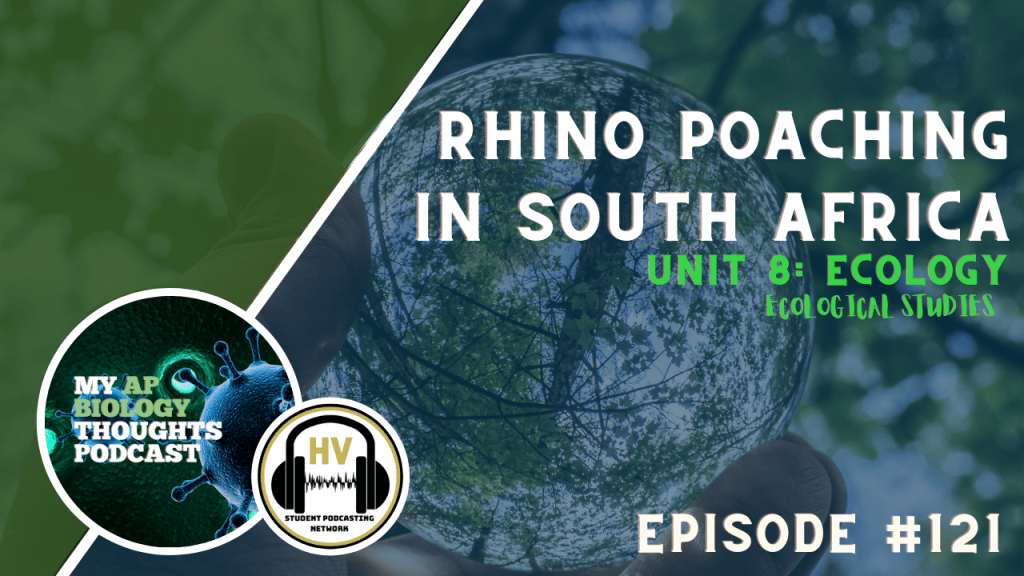Rhino Poaching in South Africa

My AP Biology Thoughts
Unit 8 Ecology
EPISODE TITLE: South African Rhino Poaching
Welcome to My AP Biology Thoughts podcast, my name is Keenan Wallace and I am your host for this episode called Unit 8 Ecology-Threatened Rhinos in South Africa. Today we will be discussing South African Rhino Poaching and how it relates to the AP Biology Curriculum.
Segment 1: Overview of Rhino Poaching
- numbers poached rising in recent years:
- 13 Rhinos poached in 2007, peaked in 2015
- 1175 Rhinos killed in south africa in 2015 (more than 3 a day),
- number poached has since declined with 394 killed in 2020
- Rhino population has decreased from 1 million in the 1800s to only 27,000 in the wild today.
- Rhinos are a keystone species: They play an integral role in their ecosystem and many other species in the ecosystem depend on their presence
Segment 2: Evidence that supports dangers of rhino poaching
- Rhinos are so large that they actually Geo-form: change the land around them
- Rhinos often wallow in mud to keep cool and ward off insects.
- This helps maintain waterholes
- When the rhinos get out they track the fertile, nutrient rich soil that accumulates in waterholes far and wide, distributing the nutrients.
- Rhino dung supports other species and food chains
- Rhino dung fertilizes soil
- Dung beetles lay their eggs in rhino dung, which also supports species that eat the beetle larvae
- A number of bird species rely on Rhino dung for insects and seeds.
- Rhinos support fly and tick species as well as animals that eat them, like terrapins (a kind of turtle) and oxpeckers (the iconic symbiotic relationship)
- Keep grass short, allowing plant species that can’t survive among long grass to thrive.
Segment 3: Connection to the Course
- Without rhinos, all of these roles would be left unfilled and with its foundation gone the ecosystems would begin to collapse. (keystone species)
- When you hear about rhino conservation, this is why it matters.
Thank you for listening to this episode of My AP Biology Thoughts. For more student-ran podcasts and digital content, make sure that you visit www.hvspn.com.
Music Credits:
- “Ice Flow” Kevin MacLeod (incompetech.com)
- Licensed under Creative Commons: By Attribution 4.0 License
- http://creativecommons.org/licenses/by/4.0/
Subscribe to our Podcast
Connect with us on Social Media
Twitter @thehvspn
Sources:
“Vanishing Rhinos – The Impact of Rhino Poaching on the South African Ecosystem. (n.d.). The Scientista Foundation.” The Scientista Foundation, http://www.scientistafoundation.com/lifestyle-blog/-vanishing-rhinos-the-impact-of-rhino-poaching-on-the-south-african-ecosystem. Accessed 1 Dec. 2021.
“Poaching Numbers | Conservation | Save the Rhino International.” Save The Rhino, https://www.facebook.com/savetherhinointernational/, https://www.savetherhino.org/rhino-info/poaching-stats/. Accessed 1 Dec. 2021.
“Why Are Rhinos Important for Ecosystems? – Africa Geographic.” Africa Geographic, https://www.facebook.com/Africa.Geographic, 25 May 2020, https://africageographic.com/stories/why-are-rhinos-important-for-ecosystems/.

